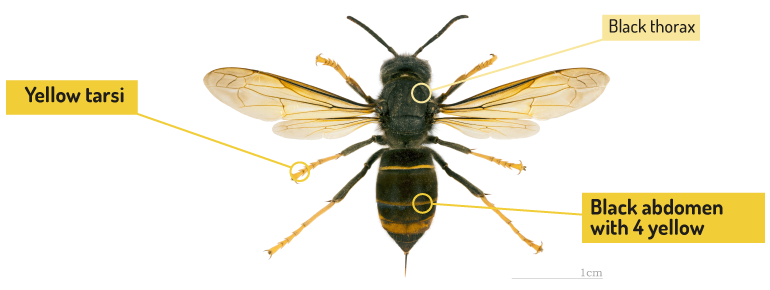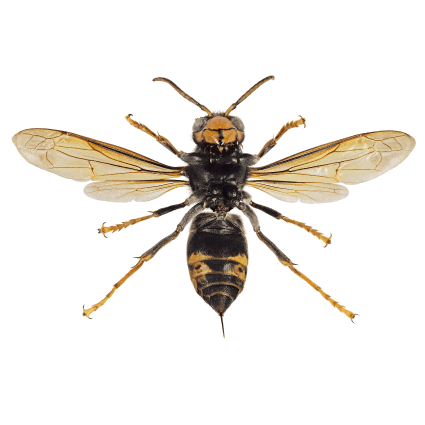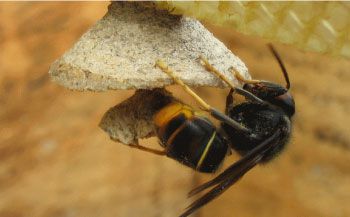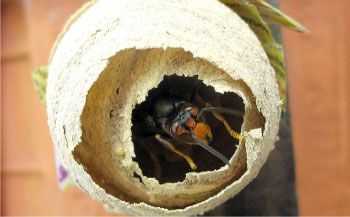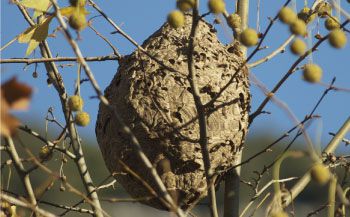The vespa velutina
(Asian hornet)
The Asian hornet or yellow-legged hornet (Vespa Velutina) is a hymenoptera from the Vespidae family,
from the subfamily Vespinae and of the genus Vespa.
It is an invasive species..
Toulouse Museum
[CC BY-SA 3.0 (https://creativecommons.org/licenses/by-sa/3.0)], de Wikimedia Commons
In April 2017, the hornet had nearly colonised the whole of France, Portugal, North Spain and some regions in Italy, Germany, Belgium and Great Britain.
It is a diurnal species.
Workers measure 3 cm, a queen 3.5 cm
Its territorial progression is about 60 km per year.
Its diet
The hornet is an opportunistic predator that hunts different insects (bees, flies, dragon flies, orthoptera) including flesh from fruit in autumn.
In order to capture bees, it hovers near the entrance of a beehive or next to the areas of collection. Its larger size and large legs allow it to catch a bee and take it with it. It forms balls with its prey and takes them to its nest to feed the larvae.
Adults can only feed themselves with liquid (nectar, honey…) their source of protein comes from the liquid which the larvae regurgitate. Just like bees, workers carry around the liquids in their mouth to feed the other adults of the nest.
Its life cycle
The queen has a lifespan of one year.
Each queen starts her own colony in the spring during the month of March until the beginning of August. It is composed of larvae which will become the first workers, namely, the first brood.
At the start of the month of June, the colony is comprised of adult workers and towards the end of the summer also of sexual males and females.
Sexual females, future queens, spend winter in a sheltered place, usually underground, and come out in the spring to start new colonies. Queens are fertilized by males and store the seed in their spermatheca (pocket containing spermatozoons). The females lay fertilised eggs and have other females. However, when they have no more spermatozoons, such as virgin females, they produce unfertilised eggs, hence males.
Thus the absence of fertilisation can lead to the death of the colony.
Its nest :
Queen Vespa Velutina will build 2 nests made of chewed cellulose fibre:
In Spring (March to June) when it comes out of the place where it stayed during winter, it will build a primary nest.
It lays a few eggs and takes care of its first larvae which will become, from one month to a month and a half- depending on the temperature – adult workers capable of taking charge of the building of the nest and upkeep of the colony.
These nests are generally not located very high up (under eaves, garages, empty nests,…).
In June, the colony develops and will migrate higher up and build a larger nest, It can attain one meter in height and 80 cm in diameter, most often located in trees higher than 10 meters. Needing a lot of water both to build its nest and to feed its larvae, Asian hornets always settle next to a watering hole (river or fountain).
Usually, the nest is spherical in form and has a lateral outlet orifice. Each nest houses about 2000 to 10000 hornets, according to size, including more than 550 founders which, the following year, can nest if they are fertilised. The nest has a lateral entrance.
It is abandoned during the winter. In France, during the winter period, it has been observed that some birds ravaged the nest. This behaviour does not affect the life expectancy of the species since the nest is empty.

In Europe, there are no predators or regulators of Vespa Velutina.
The STOP IT ® creates a transparent barrier which keeps killer hornets away from your hive, while providing safe outlets for the bees, allowing them to fly safely in and out of the nest for their food.




